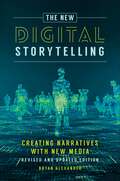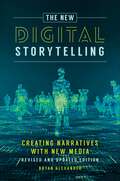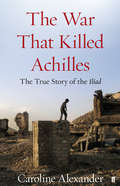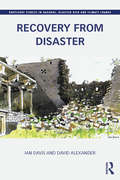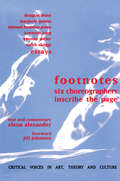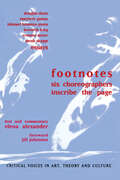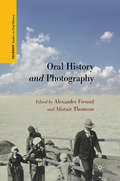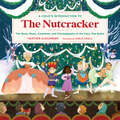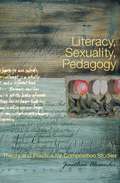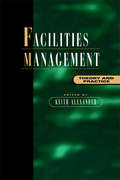- Table View
- List View
The New Digital Storytelling: Creating Narratives with New Media--Revised and Updated Edition
by Bryan AlexanderNewly revised and updated, this is the essential guide to state-of-the-art digital storytelling for audiences, creators, and teachers.Written for everyone interested in the communication potential of digital media, including educators, marketers, communication professionals, and community activists, this is the ultimate guide to harnessing technology for storytelling. No other book covers the digital storytelling movement as thoroughly as this updated second edition of a popular work, nor does any incorporate as many technologies, from video to augmented reality, mobile devices to virtual reality.The book combines history, analysis, and practical guidance about digital storytelling. It begins with a history that encompasses an exploration of storytelling itself, as well as a description of narratives using digital tools from the 1980s through 2000. From there, the author dives into modern digital storytelling, offering analysis and guidance regarding the use of digital video, podcasting, social media, gaming, mobile devices, and virtual and augmented reality. The work concludes with practical advice about how to create and share digital stories using the most current tools so even the new would-be storyteller can create their first digital narrative. Of course, the second edition is updated to take into account the many ways the field has advanced since the original book appeared. With many new examples of digital stories, this edition's evidence base is current and fresh. New or transformed technologies are also addressed, including virtual reality; mobile devices that have become mainstream tools for creating, sharing, and experiencing digital stories; and the wide variety of new storytelling apps and services.
The New Digital Storytelling: Creating Narratives with New Media--Revised and Updated Edition
by Bryan AlexanderNewly revised and updated, this is the essential guide to state-of-the-art digital storytelling for audiences, creators, and teachers.Written for everyone interested in the communication potential of digital media, including educators, marketers, communication professionals, and community activists, this is the ultimate guide to harnessing technology for storytelling. No other book covers the digital storytelling movement as thoroughly as this updated second edition of a popular work, nor does any incorporate as many technologies, from video to augmented reality, mobile devices to virtual reality.The book combines history, analysis, and practical guidance about digital storytelling. It begins with a history that encompasses an exploration of storytelling itself, as well as a description of narratives using digital tools from the 1980s through 2000. From there, the author dives into modern digital storytelling, offering analysis and guidance regarding the use of digital video, podcasting, social media, gaming, mobile devices, and virtual and augmented reality. The work concludes with practical advice about how to create and share digital stories using the most current tools so even the new would-be storyteller can create their first digital narrative. Of course, the second edition is updated to take into account the many ways the field has advanced since the original book appeared. With many new examples of digital stories, this edition's evidence base is current and fresh. New or transformed technologies are also addressed, including virtual reality; mobile devices that have become mainstream tools for creating, sharing, and experiencing digital stories; and the wide variety of new storytelling apps and services.
Universities on Fire: Higher Education in the Climate Crisis
by Bryan AlexanderScientists agree that we are on the precipice of a global climate crisis. How will it transform colleges and universities?In 2019, intense fires in the San Francisco Bay Area closed universities and drove afflicted people to shelter at other campuses. At the same time, extraordinary fires ravaged eastern Australia. Several universities responded by promising material and research support to damaged businesses while also hosting refugees and emergency response teams in student residence halls. This was an echo of the devastation wreaked by Hurricane Katrina on Tulane University in 2005.In Universities on Fire, futurist Bryan Alexander explores higher education during an age of unfolding climate crisis. Powered by real-world examples and the latest research, Alexander assesses practical responses and strategies by surveying contemporary programs and academic climate research from around the world. He establishes a model of how academic institutions may respond and offers practical pathways forward for higher education. How will the two main purposes of education—teaching and research—change as the world heats up? Alexander positions colleges and universities in the broader social world, from town-gown relationships to connections between how campuses and civilization as a whole respond to this epochal threat.Current studies of climate change trace the likely implications across a range of domains, from agriculture to policy, urban design, technology, culture, and human psychology. However, few books have predicted or studied the effects of the climate crisis on colleges and universities. By connecting climate research to a deep, futures-informed analysis of academia, Universities on Fire explores how climate change will fundamentally reshape higher education.
Universities on Fire: Higher Education in the Climate Crisis
by Bryan AlexanderScientists agree that we are on the precipice of a global climate crisis. How will it transform colleges and universities?In 2019, intense fires in the San Francisco Bay Area closed universities and drove afflicted people to shelter at other campuses. At the same time, extraordinary fires ravaged eastern Australia. Several universities responded by promising material and research support to damaged businesses while also hosting refugees and emergency response teams in student residence halls. This was an echo of the devastation wreaked by Hurricane Katrina on Tulane University in 2005.In Universities on Fire, futurist Bryan Alexander explores higher education during an age of unfolding climate crisis. Powered by real-world examples and the latest research, Alexander assesses practical responses and strategies by surveying contemporary programs and academic climate research from around the world. He establishes a model of how academic institutions may respond and offers practical pathways forward for higher education. How will the two main purposes of education—teaching and research—change as the world heats up? Alexander positions colleges and universities in the broader social world, from town-gown relationships to connections between how campuses and civilization as a whole respond to this epochal threat.Current studies of climate change trace the likely implications across a range of domains, from agriculture to policy, urban design, technology, culture, and human psychology. However, few books have predicted or studied the effects of the climate crisis on colleges and universities. By connecting climate research to a deep, futures-informed analysis of academia, Universities on Fire explores how climate change will fundamentally reshape higher education.
The War That Killed Achilles: The True Story Of Homer's Iliad And The Trojan War
by Caroline AlexanderThe Iliad is still the greatest poem about war that our culture has ever produced. For a hundred generations, poets and thinkers in the West have pored over, retold and argued about the events described in this martial epic, even when direct knowledge of it was lost. Various empires have admired it as a book that in telling the story of the siege of Troy also extols the warrior ethic, and teaches the young how to die well.Yet the figure at the heart of the epic, the consummate warrior Achilles, is a brooding, controversial hero. He is a fierce critic of those who have started this war and allowed it to drag on, consuming soldiers and civilians alike. Disconcertingly, The Iliad portrays war as a catastrophe that destroys cities, orphans children and wrecks whole societies.Caroline Alexander's extraordinary book is not about any of the traditional concerns that have occupied classicists for centuries. It is simpler and more radical than that. In her words, 'This book is about what the Iliad is about; this book is about what the Iliad says of war.'
Notes on the Synthesis of Form
by Christopher Alexander“These notes are about the process of design: the process of inventing things which display new physical order, organization, form, in response to function.” This book, opening with these words, presents an entirely new theory on the process of design.
A Pattern Language: Towns, Buildings, Construction (Center for Environmental Structure Series)
by Christopher AlexanderYou can use this book to design a house for yourself with your family; you can use it to work with your neighbors to improve your town and neighborhood; you can use it to design an office, or a workshop, or a public building. And you can use it to guide you in the actual process of construction. After a ten-year silence, Christopher Alexander and his colleagues at the Center for Environmental Structure are now publishing a major statement in the form of three books which will, in their words, "lay the basis for an entirely new approach to architecture, building and planning, which will we hope replace existing ideas and practices entirely." The three books are The Timeless Way of Building, The Oregon Experiment, and this book, A Pattern Language. At the core of these books is the idea that people should design for themselves their own houses, streets, and communities. This idea may be radical (it implies a radical transformation of the architectural profession) but it comes simply from the observation that most of the wonderful places of the world were not made by architects but by the people. At the core of the books, too, is the point that in designing their environments people always rely on certain "languages," which, like the languages we speak, allow them to articulate and communicate an infinite variety of designs within a forma system which gives them coherence. This book provides a language of this kind. It will enable a person to make a design for almost any kind of building, or any part of the built environment. "Patterns," the units of this language, are answers to design problems (How high should a window sill be? How many stories should a building have? How much space in a neighborhood should be devoted to grass and trees?). More than 250 of the patterns in this pattern language are given: each consists of a problem statement, a discussion of the problem with an illustration, and a solution. As the authors say in their introduction, many of the patterns are archetypal, so deeply rooted in the nature of things that it seemly likely that they will be a part of human nature, and human action, as much in five hundred years as they are today.
A Pattern Language: Towns, Buildings, Construction (Center for Environmental Structure Series)
by Christopher AlexanderYou can use this book to design a house for yourself with your family; you can use it to work with your neighbors to improve your town and neighborhood; you can use it to design an office, or a workshop, or a public building. And you can use it to guide you in the actual process of construction. After a ten-year silence, Christopher Alexander and his colleagues at the Center for Environmental Structure are now publishing a major statement in the form of three books which will, in their words, "lay the basis for an entirely new approach to architecture, building and planning, which will we hope replace existing ideas and practices entirely." The three books are The Timeless Way of Building, The Oregon Experiment, and this book, A Pattern Language. At the core of these books is the idea that people should design for themselves their own houses, streets, and communities. This idea may be radical (it implies a radical transformation of the architectural profession) but it comes simply from the observation that most of the wonderful places of the world were not made by architects but by the people. At the core of the books, too, is the point that in designing their environments people always rely on certain "languages," which, like the languages we speak, allow them to articulate and communicate an infinite variety of designs within a forma system which gives them coherence. This book provides a language of this kind. It will enable a person to make a design for almost any kind of building, or any part of the built environment. "Patterns," the units of this language, are answers to design problems (How high should a window sill be? How many stories should a building have? How much space in a neighborhood should be devoted to grass and trees?). More than 250 of the patterns in this pattern language are given: each consists of a problem statement, a discussion of the problem with an illustration, and a solution. As the authors say in their introduction, many of the patterns are archetypal, so deeply rooted in the nature of things that it seemly likely that they will be a part of human nature, and human action, as much in five hundred years as they are today.
Recovery from Disaster (Routledge Studies in Hazards, Disaster Risk and Climate Change)
by David Alexander Ian DavisDisasters can dominate newspaper headlines and fill our TV screens with relief appeals, but the complex long-term challenge of recovery—providing shelter, rebuilding safe dwellings, restoring livelihoods and shattered lives—generally fails to attract the attention of the public and most agencies. On average 650 disasters occur each year. They affect more than 200 million people and cause $166 trillion of damage. Climate change, population growth and urbanisation are likely to intensify further the impact of natural disasters and add to reconstruction needs. Recovery from Disaster explores the field and provides a concise, comprehensive source of knowledge for academics, planners, architects, engineers, construction managers, relief and development officials and reconstruction planners involved with all sectors of recovery, including shelter and rebuilding. With almost 80 years of first-hand experience of disaster recovery between them, Ian Davis (an architect) and David Alexander (a geographer) draw substantially from first-hand experiences in a variety of recovery situations in China, Haiti, Italy, Japan, New Zealand, Pakistan, the Philippines and the USA. The volume is further enriched by two important and unique features: 21 models of disaster recovery are presented, seven of which were specifically developed for the book. The second feature is a survey of expert opinion about the nature of effective disaster recovery—the first of its kind. More than 50 responses are provided in full, along with an analysis that integrates them with the theories that underpin them. By providing a framework and models for future study and applications, Davis and Alexander seek both to advance the field and to provide a much-needed reference work for decision makers. With a broad perspective derived from the authors' roles held as university professors, researchers, trainers, consultants, NGO directors and advisors to governments and UN agencies, this comprehensive guide will be invaluable for practitioners and students of disaster management.
Recovery from Disaster (Routledge Studies in Hazards, Disaster Risk and Climate Change)
by David Alexander Ian DavisDisasters can dominate newspaper headlines and fill our TV screens with relief appeals, but the complex long-term challenge of recovery—providing shelter, rebuilding safe dwellings, restoring livelihoods and shattered lives—generally fails to attract the attention of the public and most agencies. On average 650 disasters occur each year. They affect more than 200 million people and cause $166 trillion of damage. Climate change, population growth and urbanisation are likely to intensify further the impact of natural disasters and add to reconstruction needs. Recovery from Disaster explores the field and provides a concise, comprehensive source of knowledge for academics, planners, architects, engineers, construction managers, relief and development officials and reconstruction planners involved with all sectors of recovery, including shelter and rebuilding. With almost 80 years of first-hand experience of disaster recovery between them, Ian Davis (an architect) and David Alexander (a geographer) draw substantially from first-hand experiences in a variety of recovery situations in China, Haiti, Italy, Japan, New Zealand, Pakistan, the Philippines and the USA. The volume is further enriched by two important and unique features: 21 models of disaster recovery are presented, seven of which were specifically developed for the book. The second feature is a survey of expert opinion about the nature of effective disaster recovery—the first of its kind. More than 50 responses are provided in full, along with an analysis that integrates them with the theories that underpin them. By providing a framework and models for future study and applications, Davis and Alexander seek both to advance the field and to provide a much-needed reference work for decision makers. With a broad perspective derived from the authors' roles held as university professors, researchers, trainers, consultants, NGO directors and advisors to governments and UN agencies, this comprehensive guide will be invaluable for practitioners and students of disaster management.
Footnotes: Six Choreographers Inscribe the Page (Critical Voices in Art, Theory and Culture)
by Elena Alexander Jill Johnston Douglas Dunn Marjorie Gamso Ishmael Houston-Jones Kenneth King Yvonne Meier Sarah SkaggsFirst Published in 1998. Routledge is an imprint of Taylor & Francis, an informa company.
Footnotes: Six Choreographers Inscribe the Page (Critical Voices in Art, Theory and Culture)
by Elena Alexander Jill Johnston Douglas Dunn Marjorie Gamso Ishmael Houston-Jones Kenneth King Yvonne Meier Sarah SkaggsFirst Published in 1998. Routledge is an imprint of Taylor & Francis, an informa company.
Oral History and Photography (Palgrave Studies in Oral History)
by Alexander Freund & Alistair ThomsonThis book collects original research essays to explore the diverse uses of photographs and photography in oral history, from the use of photos as memory triggers to their deployment in the telling of life stories. The book's contributors include both oral historians and photography scholars and critics.
A Child's Introduction to the Nutcracker: The Story, Music, Costumes, and Choreography of the Fairy Tale Ballet (A Child's Introduction Series)
by Heather AlexanderBallet enthusiasts of all ages will delight in the magical story of The Nutcracker and the magnificent ballet it inspired in this enchanted book packed with colorful illustrations, fun facts, history, music, and the love of dance. Whether The Nutcracker is your first ballet experience or you&’re already a master dancer, everything you love and want to know about this special, sugar-spun, snow-dusted ballet can be found in these delightful pages. Follow The Nutcracker as it makes its way from page to stage to become the world&’s most popular holiday ballet. Learn all about the dazzling steps, spins, and jumps choreographed by Petipa, Ivanov, and Balanchine, and meet the famed composer Tchaikovsky. Special sections highlight some of the most famous dancers and companies that have brought the performance and the magic of this ballet to life.Packed with charming illustrations showcasing the beautiful costumes and lavish sets, plus removable poster for you to color, A Child&’s Introduction to the Nutcracker lets you to enjoy this magical ballet all year round!
Perspectives on Place: Theory and Practice in Landscape Photography
by J.A.P. AlexanderPerspectives on Place provides an inspiring insight into the territory of landscape photography. Using a range of historic and contemporary examples, Alexander explores the rich and diverse history of landscape photography and the many ways in which contemporary photographers engage with the landscape and their surroundings.Bridging theory and practice, this book demonstrates how mastering a variety of different photographic techniques can help you communicate ideas, explore themes, and develop more abstract concepts. With practical guidance on everything from effective composition, to managing challenging lighting conditions and working with different lenses and formats, you’ll be able to build your own varied and creative portfolio.Each chapter concludes with discussion questions and an assignment, encouraging you to explore key concepts and apply different photographic techniques to your own practice. Richly illustrated with images from some of the world’s most influential photographers, Perspectives on Place will help you to explore the visual qualities of your images and represent your surroundings more meaningfully.
Perspectives on Place: Theory and Practice in Landscape Photography
by J.A.P. AlexanderPerspectives on Place provides an inspiring insight into the territory of landscape photography. Using a range of historic and contemporary examples, Alexander explores the rich and diverse history of landscape photography and the many ways in which contemporary photographers engage with the landscape and their surroundings.Bridging theory and practice, this book demonstrates how mastering a variety of different photographic techniques can help you communicate ideas, explore themes, and develop more abstract concepts. With practical guidance on everything from effective composition, to managing challenging lighting conditions and working with different lenses and formats, you’ll be able to build your own varied and creative portfolio.Each chapter concludes with discussion questions and an assignment, encouraging you to explore key concepts and apply different photographic techniques to your own practice. Richly illustrated with images from some of the world’s most influential photographers, Perspectives on Place will help you to explore the visual qualities of your images and represent your surroundings more meaningfully.
Granny's Kitchen Cupboard: A Lifetime In Over 100 Objects
by John AlexanderAccumulated over many years, 'Granny', the enigmatic collector behind this book, presents a selection of quirky post-war goods, advertising and kitchen items.
Literacy, Sexuality, Pedagogy: Theory and Practice for Composition Studies
by Jonathan AlexanderDespite its centrality to much of contemporary personal and public discourse, sexuality remains infrequently discussed in most composition courses, and in our discipline at large. Moreover, its complicated relationship to discourse, to the very languages we use to describe and define our worlds, is woefully understudied in our discipline. Discourse about sexuality, and the discourse of sexuality, surround us—circulating in the news media, on the Web, in conversations, and in the very languages we use to articulate our interactions with others and our understanding of ourselves. It forms a core set of complex discourses through which we approach, make sense of, and construct a variety of meanings, politics, and identities. In Literacy, Sexuality, Pedagogy, Jonathan Alexander argues for the development of students' "sexual literacy." Such a literacy is not just concerned with developing fluency with sexuality as a "hot" topic, but with understanding the intimate interconnectedness of sexuality and literacy in Western culture. Using the work of scholars in queer theory, sexuality studies, and the New Literacy Studies, Alexander unpacks what he sees as a crucial--if often overlooked--dimension of literacy: the fundamental ways in which sexuality has become a key component of contemporary literate practice, of the stories we tell about ourselves, our communities, and our political investments. Alexander then demonstrates through a series of composition exercises and writing assignments how we might develop students' understanding of sexual literacy. Examining discourses of gender, heterosexuality, and marriage allows students (and instructors) a critical opportunity to see how the languages we use to describe ourselves and our communities are saturated with ideologies of sexuality. Understanding how sexuality is constructed and deployed as a way to "make meaning" in our culture gives us a critical tool both to understand some of the fundamental ways in which we know ourselves and to challenge some of the norms that govern our lives. In the process, we become more fluent with the stories that we tell about ourselves and discover how normative notions of sexuality enable (and constrain) narrations of identity, culture, and politics. Such develops not only our understanding of sexuality, but of literacy, as we explore how sexuality is a vital, if vexing, part of the story of who we are.
A Data-Driven Analysis of Cemeteries and Social Reform in Paris, 1804–1924 (Routledge Research in Art History)
by Kaylee P. AlexanderThis book takes a novel, data-driven approach to the cemeteries of Paris, analyzing a largely text-based body of archival material as proxy evidence for visual material that has been lost due to systematic, and legally sanctioned, acts of erasure. This study represents the first full-length study of vernacular monuments in France and the entrepreneurs who made them. It also provides methodical considerations, at the intersection of the computational and digital humanities for managing survival biases in extant historical evidence, that are applicable beyond the thematic focus of this book. Since extant examples of these more inconspicuous monuments are rare, this project employs both distant and close viewing—analyzing commercial almanacs, work logs, and burial records in aggregates alongside detailed case studies—to compensate for gaps in the material record. The book will be of interest to scholars working in visual culture, popular culture, digital humanities and French history.
A Data-Driven Analysis of Cemeteries and Social Reform in Paris, 1804–1924 (Routledge Research in Art History)
by Kaylee P. AlexanderThis book takes a novel, data-driven approach to the cemeteries of Paris, analyzing a largely text-based body of archival material as proxy evidence for visual material that has been lost due to systematic, and legally sanctioned, acts of erasure. This study represents the first full-length study of vernacular monuments in France and the entrepreneurs who made them. It also provides methodical considerations, at the intersection of the computational and digital humanities for managing survival biases in extant historical evidence, that are applicable beyond the thematic focus of this book. Since extant examples of these more inconspicuous monuments are rare, this project employs both distant and close viewing—analyzing commercial almanacs, work logs, and burial records in aggregates alongside detailed case studies—to compensate for gaps in the material record. The book will be of interest to scholars working in visual culture, popular culture, digital humanities and French history.
Facilities Management: Theory and Practice
by Keith AlexanderThis text provides an overview of the interdisciplinary nature of facilities management. It discusses the framework within which facilites managers should operate and the key requirements of their task.
Facilities Management: Theory and Practice
by Keith AlexanderThis text provides an overview of the interdisciplinary nature of facilities management. It discusses the framework within which facilites managers should operate and the key requirements of their task.
Facilities Management: Innovation and Performance
by Keith Alexander Brian Atkin Jan Brochner Tore I. HaugenFacilities Management sets out a new framework for the discipline of facilities management which challenges many of the norms and which sets out new methods for optimising the performance of a business. Successful facilities managers need a range of skills and need to be able to devise a range of innovative strategies for the future of the organisations in which they work.This new book follows on directly from Keith Alexander's ground-breaking textbook Facilities Management and focuses on four new themes which have been identified as keys to the new strategy: organisational change and learning, innovation, performance and the knowledge workplace.
Kompendium der visuellen Information und Kommunikation (X.media.press)
by Kerstin AlexanderPraktiker müssen zunehmend ihr Wissen professionell und attraktiv aufbereiten. Dieses Kompendium zeigt Ihnen Informationsdesign von der Grafik bis hin zum Dokument. Wie Sie Präsentationen bewerten, erstellen und verbessern. Mit 200 farbigen Abbildungen zu Technik, Prozessen und Informationsaufbereitung. Die Autorin erläutert Wahrnehmung, Ideenfindung, Illustrationsmethoden, Typografie, Layout sowie das Zusammenspiel von Text und Bild im Designkonzept. Ein ideales Fachbuch für Studierende und Fachkräfte, die mittels Gestaltung Ideen und Informationen transportieren wollen. Die hohe Qualität der Abbildungen lädt zum Genießen und Blättern ein.
Kompendium der visuellen Information und Kommunikation (X.media.press)
by Kerstin AlexanderWie gestalte ich Handlungsabläufe, Datenmengen, Prozesse, Animationen, Perspektiven, Piktogramme, Schnitte, Bedienoberflächen von Software oder das Interface von Automaten? Wie kann ich Bilder für abstrakte Zusammenhänge finden? Was muss ich über Layout wissen? Welche Anforderungen haben technische Grafiken? Wie kann ich sie effektiv aus 3D-Konstruktionsdaten erstellen? Das „Kompendium der visuellen Information und Kommunikation“ ist ein Buch, das von Machern für Macher geschrieben wurde. Step by Step werden in Wort und Bild Illustrationswege und Methoden der grafischen Ideenfindung vorgestellt. Checklisten ermöglichen eine Qualitätskontrolle. Die neue Auflage geht intensiv auf die Gestaltung von technischen Grafiken, Benutzer-Interfaces, Multimedia-Interfaces und Interfaces zur Steuerung komplexer Prozesse ein.
